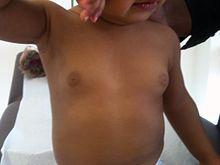| Premature thelarche | |
|---|---|
 | |
| Infant with premature thelarche | |
| Specialty | Gynecology, endocrinology |
Premature thelarche (PT) is a medical condition, characterised by isolated breast development in female infants. It occurs in females younger than 8 years, with the highest occurrence before the age of 2. PT is rare, occurring in 2.2-4.7% of females aged 0 to 2 years old.[1] The exact cause of the condition is still unknown, but it has been linked to a variety of genetic, dietary and physiological factors.[2]
PT is a form of Incomplete Precocious Puberty (IPP). IPP is the presence of a secondary sex characteristic in an infant, without a change in their sex hormone levels. Central Precocious Puberty (CPP) is a more severe condition than IPP. CPP is the presentation of secondary sex characteristics, with a change in sex hormones due to alteration of the hypothalamic-pituitary-gonadal (HPG) axis.[1] CPP is an aggressive endocrine disorder with harmful developmental consequences for the patient. At the presentation of PT, diagnostics are used to ensure it is not early stage CPP. CPP can be differentiated from PT through biochemical testing, ultrasounds and ongoing observation.[3] There is no treatment for PT but regular observation is important to ensure it does not progress to CPP. CPP diagnosis is important as treatment is necessary.[1]
- ^ a b c Khokar A, Mojia A (2018). "Premature Thelarche". Pediatric Annals. 47 (1): 12–15.
- ^ Rezkalla J, Von Wald T, Hansen KA (June 2017). "Premature Thelarche and the PURA Syndrome". Obstetrics and Gynecology. 129 (6): 1037–1039. doi:10.1097/AOG.0000000000002047. PMID 28486374.
- ^ Lee SH, Joo EY, Lee JE, Jun YH, Kim MY (January 2016). "The Diagnostic Value of Pelvic Ultrasound in Girls with Central Precocious Puberty". Chonnam Medical Journal. 52 (1): 70–4. doi:10.4068/cmj.2016.52.1.70. PMC 4742613. PMID 26866003.